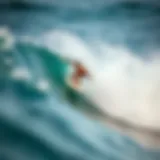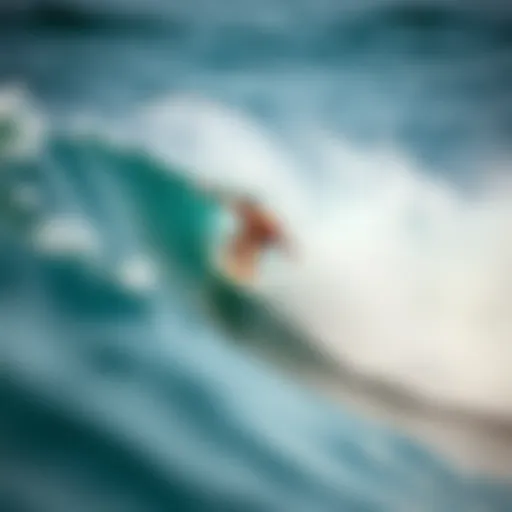Exploring Man-Made Waves: Innovation and Impact
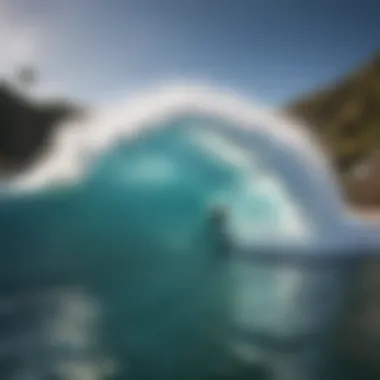

Intro
In recent years, the surf community has witnessed a groundbreaking shift with the advent of man-made waves. The introduction of these artificial wave systems has not only opened up possibilities for surf enthusiasts but has also stirred a complex dialogue about their impact on the environment and local surf culture. With advanced engineering at the helm, these innovations promise an exciting future for the sport, yet they also raise crucial questions about sustainability and ecosystem health.
The engineering behind man-made waves merges technology, creativity, and surf culture, enabling facilities to generate consistent and quality waves regardless of nature's whims. It’s not just about riding a board; it’s about the integration of leisure, competition, and respect for our surroundings. The ability to surf in urban environments and places far from the ocean has profound implications for accessibility and the growth of surfing as a sport.
But as we delve into this intricate narrative, we must also consider the competing interests of recreational surfing, economic growth, and environmental preservation. This blend of innovative spirit and grounding responsibility is what drives the conversation surrounding man-made waves.
Exploring the multifaceted aspects of this topic will shed light on the technologies improving surfing experiences, the ongoing dialogue about sustainability, and how these changing waves influence both surf culture and environmental stewardship.
Intro to Man-Made Waves
The rise of man-made waves in the surfing world represents a significant shift in how enthusiasts approach the sport. It’s not just about riding the waves; it’s about the growth of a culture that embraces technology and the potential for year-round surfing. These engineered waves not only offer consistent riding conditions but also attract a diverse crowd of surfers, from beginners to seasoned pros. As we dive into this topic, it becomes clear that understanding these artificial constructs is pivotal in appreciating the broader implications for surfing, the environment, and local economies.
Definition and Concept
Man-made waves refer to artificially created surfable waves, designed to mimic natural ocean conditions. These waves are produced using various technologies that replicate the dynamic movements of water. The concept is simple yet profound: by designing and controlling the wave-making process, surfers can experience prime surf conditions regardless of geographic limitations or weather patterns.
Some common terms used in this context include "wave pools," "surf parks," and "wave generation systems." Each of these entities employs different technologies to create diverse wave types. Their purpose is to enhance the surfing experience, provide training opportunities, and promote surf culture in regions where natural waves may be scarce.
Historical Context
The idea of creating artificial waves isn’t as new as many would think. The earliest attempts can be traced back to the mid-20th century, particularly with the introduction of wave pools aimed at entertainment rather than serious surfing. Facilities such as the "Big Surf" in Tempe, Arizona, opened in 1969, were pivotal. Though they offered a unique experience, they didn’t adequately cater to the demands of proficient surfers who sought more substantial and challenging waves.
As technology advanced, so did the capability to produce higher-quality surfable waves. The groundbreaking work by engineers like Tom Carroll and the conception of wave-making devices in the early 2000s ushered in a new era for surf parks.
These developments led to the emergence of notable facilities such as the "Surf Ranch" created by Kelly Slater in 2015, which showcased a new standard for artificial wave quality and precision. This evolution signifies a coming-of-age moment for man-made waves, transforming them into vital components of surfing culture globally.
"Artificial waves have opened doors for surfers everywhere, allowing them to hone their skills and enjoy their passion regardless of the ocean's whims."
Thus, on both a local and global scale, the emergence of engineered waves has created fresh avenues for sporting activities, tourism, and community building, shaping the future of surfing in an intricate dance between nature and technology.
The Science of Wave Generation
The field of wave generation is crucial in shaping the experience of surfing in man-made environments. By understanding the specific mechanics behind these generated waves, surf enthusiasts and engineers can design facilities that not only replicate natural ocean conditions but also offer unique challenges for surfers. The significance lies in the blending of science and sport, where the technical aspects must align seamlessly with the aesthetics and thrill of riding waves.
Fundamental Principles
The essence of wave generation can be distilled into a few fundamental principles. Waves form due to the interaction of energy with water; this can be through wind, seismic activity, or mechanical means in artificial settings. The characteristics of these waves, such as height, frequency, and duration, are largely influenced by the energy imparted and the structure of the wave-generating system.
An important concept is the conservation of energy. When energy is applied to create these waves, it travels through the water, forming ripples and swells. The aim in wave design is to maximize this energy transfer while minimizing losses, ensuring that surfers can enjoy consistent and enjoyable rides. Additionally, tuning parameters such as phase and amplitude allows for adjustments to the waves, making them suitable for both novices and seasoned surfers.
Types of Wave Generators
Understanding the different types of wave generators helps in comprehending their unique benefits, operational principles, and overall contributions to artificial wave development.
Mechanical Wave Systems
Mechanical wave systems are fascinating examples of engineering ingenuity. These systems utilize physical mechanisms—like paddles or fins—to create motion in the water. One of the key characteristics is their ability to produce powerful waves on demand, which makes them a favorite among developers. The benefit is that they can be adjusted for various wave sizes and types, catering to a broad range of surfers.
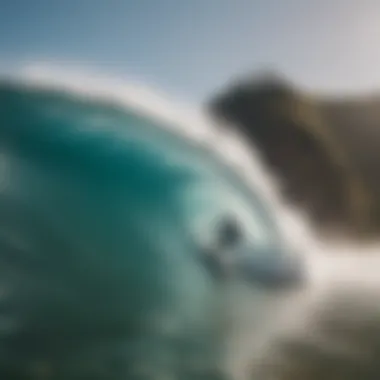

A unique feature of mechanical systems is their controllability. Operators can fine-tune the wave form in real-time, offering a customizable surfing experience. However, drawbacks include higher operational costs and potential mechanical failures, which can disrupt wave production.
Hydraulic Wave Pools
Hydraulic wave pools operate by using pumps to move water and create waves. Their distinguished characteristic is the use of hydraulic pressure to deliver waves in regular intervals. This design makes hydraulic pools efficient for creating waves with consistent characteristics, which is particularly beneficial for training and competitions.
Hydraulic systems are often prized for their energy efficiency and capacity for reducing operating costs over time. A notable feature is their potential for generating multi-directional waves, allowing for diverse surfing experiences in one location. Some concerns regarding hydraulic pools are related to water consumption and the overall ecological impact of large water bodies.
Air-Driven Systems
Air-driven systems represent a more innovative approach to wave generation. Utilizing jets of air, these systems create waves by displacing water, leading to the formation of surfable swells. The primary aspect of air-driven systems is their ability to offer gentle, rolling waves, ideal for beginners.
One of the appealing characteristics is their low maintenance requirements compared to mechanical systems. The ease of setting up these systems makes them suitable for temporary installations, which is a boon for events or pop-up surf spots. However, air-driven systems may lack the power needed for more advanced surfing maneuvers, thus limiting their appeal to a niche group of enthusiasts.
In summary, the science of wave generation involves a convergence of technology and surf culture, driving the evolution of surfing as both a sport and a spectacle.
By analyzing these fundamental principles and diverse systems, it becomes clear that each has its place in shaping the future of surfing in man-made environments. Each wave generator presents its own set of advantages and trade-offs, and the choice of system ultimately hinges on the intended audience and purpose.
Popular Man-Made Wave Facilities
Man-made wave facilities have been game-changers in the world of surfing. They offer a consistent surfing experience regardless of the ocean's temperament. These venues have become centers for skill development, competition, and entertainment. With the evolution of technology in wave generation, we are witnessing a surge in the popularity of these parks globally. Places with man-made waves can attract not only surfers but also the casual observer, making them multifunctional spaces.
Global Leaders in Wave Pools
A few key facilities stand out as pioneers in this burgeoning realm. These places don’t just throw together a few waves for show; they create a meticulously crafted surf experience that mimics natural ocean dynamics, while also pushing the boundaries of what's possible in wave performance and design.
Notable names include the likes of Surf Ranch, Waco Surf Park, and Aquasurf in France. Each one brings its own unique flavor to the table, contributing to the ever-growing landscape of artificial surfing. These leaders not only set the bar for wave quality but also emphasize the importance of sustainability and community in surfing culture.
Case Studies: Notable Locations
Surf Ranch by Kelly Slater
The Surf Ranch, brought to life by surfing legend Kelly Slater, is often viewed as the pinnacle of man-made waves. This facility stands out due to its groundbreaking technology that produces a variety of wave types. It’s not just about practice; the Surf Ranch has hosted competitions, including the World Surf League events, showcasing the potential of man-made venues. One of its most prized features is the ability to generate barreling waves, which many surfers dream of.
However, it’s not without its drawbacks. The cost of access can be high compared to traditional surf spots. Still, for those looking to take their skills to the next level, it offers an unmatched experience.
Waco Surf Park
Waco Surf Park, located in Texas, brings a different spin to the wave pool game. Known for its fun and friendly atmosphere, this facility features a versatile setup that caters to both beginners and advanced surfers with its variety of waves. One of its key highlights is the customizable wave settings, allowing users to experience everything from small, gentle waves to adrenaline-pumping swells.
Waco's popularity stems from the blend of surf culture and community spirit. The park hosts various events, providing opportunities for local and visiting surfers to connect. However, some may find the limited size of the wave pool to be a disadvantage when it comes to accommodating larger crowds.
Aquasurf in France
Across the Atlantic, Aquasurf in France presents a unique setting for surfing enthusiasts. This facility boasts a blend of natural elements and advanced technology, giving surfers a slightly different feel compared to its counterparts. The standout feature is its eco-friendly design, emphasizing minimal environmental impact while providing thrilling waves for all skill levels.
The charm of Aquasurf lies in its location; situated near renowned surfing beaches, it offers a perfect balance of training in controlled conditions and accessing the wild ocean. However, the somewhat unpredictable weather can occasionally affect wave quality, reminding users that while technology has advanced, it can’t fully replicate nature.
Popular man-made wave facilities not only provide waves but also foster a sense of community and opportunity for surfers to hone their skills in a controlled environment.
In summary, these wave parks are more than mere attractions. They are gateways to new opportunities, pushing the limits of surfing while balancing the needs of the surf community and the environment.
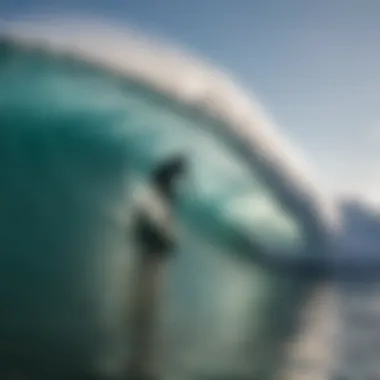

The Impact on Surf Culture
The evolution of surf culture has been intertwined with the natural rhythms of ocean swells for generations. However, the introduction of man-made waves has started to transform this culture in profound ways. Understanding how these artificial waves reshape the dynamics of surfing is essential for grasping their broader significance.
Changing Surfing Dynamics
When one reflects on the essence of surfing, images of natural ocean waves crashing against sandy shores come to mind. Yet, artificial waves have brought a new dimension to this cherished activity. In many ways, they’ve become a canvas for innovation and creativity. Unlike the unpredictable nature of ocean waves, artificial setups enable surfers to experiment with styles, techniques, and approaches without the usual variables.
This predictability allows beginners to refine their skills in a controlled environment. For instance, a novice surfer at the Surf Ranch by Kelly Slater can ride consistently breaking waves, offering them an invaluable opportunity to develop their timing and balance without the swell and currents that can often lead to frustration. With such controlled conditions, many argue that new surfers now have more opportunities to catch waves, ultimately encouraging a larger uptake in the sport.
Conversely, experienced surfers are finding ways to push their limits, sometimes showing off tricks that seemed impossible in natural conditions. There’s a vibrant level of competition that these wave pools enable, where surfers can concentrate on performance over unpredictable environments. Events and tournaments can now be held in a consistent setup, allowing for clearer comparisons of skill and technique among competitors.
"The only thing that stays constant in surfing is change; we are in a beautiful transition, with artificial waves leading the way into a new era of the sport."
Besides surf competitions, community engagement has also found a new outlet. Many surf parks are now embracing local surfers by hosting meet-ups and clinics, strengthening bonds and creating new friendships. This camaraderie plays a pivotal role in surf culture and serves as a reminder that, at its core, surfing is as much about the community as it is about the waves themselves.
Influence on Skill Development
Delving deeper into the skill development brought about by man-made waves, it becomes evident that these environments are forging the next generation of surfers. For committed enthusiasts, structured training becomes possible, as surfers can dedicate time to specific maneuvers. The inclusion of tailored sessions—focused on various skills such as carving or aerial stunts—enables surfers to elevate their game significantly.
The presence of instructors at facilities like Waco Surf Park has also ushered a new era of coaching. Many aspiring surfers can gain insights from seasoned professionals right in their midst, an experience that was once hard to come by in natural surf spots. This blend of artificial and professional guidance may be the difference that unlocks potential for many.
Structured training programs also open doors for long-term surfers looking to compete seriously. With consistent training, surfers can analyze their progress, identify weaknesses, and capitalize on their strengths, thus mastering both fundamentals and showing off style in competitions.
In places where the ocean may be unpredictable or inaccessible, such as landlocked areas, artificial wave facilities allow surf culture to flourish. The engagement of younger generations not only diversifies the surfing community but also helps preserve traditional surf culture by adapting it into new contexts.
In essence, man-made waves don’t just serve up a swell; they signify a paradigm shift in how surfers interact with their environment, refine their skills, and connect with one another. They bridge gaps, expand horizons, and transform the landscape of a sport that thrives on waves, whether real or artificially generated.
Environmental Considerations
The proliferation of man-made waves in the surfing world brings about significant environmental considerations. Acknowledging these aspects is imperative not just for surfers and water sports enthusiasts, but also for local communities and environmental advocates. Understanding the relationship between artificial wave systems and their impact on ecosystems can help mitigate adverse effects and foster more sustainable practices.
Ecosystem Impacts
Man-made wave facilities can disrupt local ecosystems in various ways. For instance, modifying water bodies to create waves can alter the natural habitats of local flora and fauna. Estuaries, which are often home to a rich diversity of species, might experience shifts in sediment patterns and water salinity. These changes can lead to heightened competition for resources among aquatic species, affecting everything from fish populations to plant life.
Additionally, the construction and operation of these wave parks often necessitates substantial water extraction from nearby rivers or lakes. This extraction can lower water levels, affecting not just the aquatic ecosystem but also the surrounding land-based wildlife that depends on these waters.
- Habitat fragmentation: Building structures for wave generation can divide habitats, making it difficult for certain animal species to thrive or migrate.
- Pollution threats: The potential for increased litter, chemical runoff, or waste products from facilities can contaminate surrounding water bodies, leading to the degradation of local ecosystems.
Understanding these potential impacts sheds light on the complex balance between the enjoyment of recreational surfing and the preservation of natural habitats. A thoughtful approach to wave facility design might include consulting with environmental scientists to predict and mitigate possible ecological disruptions.
Sustainable Practices in Wave Creation
To counterbalance the potential negative effects, it is crucial to adopt sustainable practices in wave creation. Several strategies can enhance the eco-friendliness of man-made wave systems, aiming to ensure they coexist harmoniously with the environment.
- Eco-friendly materials: Using sustainable materials during construction can reduce the carbon footprint associated with building these facilities. This encompasses everything from the concrete used for the structures to the types of flooring in wave pools.
- Water recycling systems: Implementing systems that recycle water can significantly minimize the amount of fresh water taken from natural sources. Such systems can filter and purify the water, allowing it to be reused efficiently while reducing waste.
- Habitat restoration: Some facilities engage in habitat restoration projects, actively working to rebuild local ecosystems affected by construction. This might involve planting native vegetation or creating artificial reefs to encourage marine life.
"The health of our oceans and waterways is critical to both surfing culture and environmental stability; we must cherish and protect these natural assets as we innovate in wave technology."
The integration of these sustainable practices reflects a growing awareness within the surfing community about their ecological responsibilities. Now, as technology advances, the dialogue around balancing enjoyment with environmental stewardship is more crucial than ever.
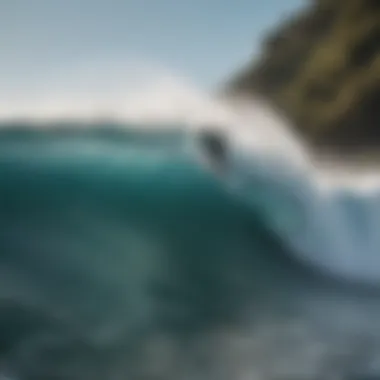

Economic Aspects of Wave Pools
The rise of man-made waves has not only revolutionized how people engage with surfing but has also brought about significant economic implications. Understanding the economic aspects of wave pools is crucial for those invested in surf culture, tourism, and environmental advocacy. This section delves into both the financial responsibilities associated with constructing and maintaining wave pools, as well as the revenue opportunities generated through increased tourism and community engagement.
Cost of Construction and Maintenance
When discussing the economics of wave pools, one cannot overlook the hefty price tags they come with. Designing and constructing a man-made wave facility involves a variety of factors that contribute to high initial costs.
- Site Preparation: Assessing and preparing the land to accommodate the waves requires extensive planning, including geological studies and possible environmental assessments. This step alone can drain substantial resources.
- Construction Materials: From concrete to specialized equipment for wave generation, the materials used can add significant costs. Moreover, durable materials are essential to withstand constant water and weather exposure, meaning the initial investment is just the beginning.
- Technology and Equipment: Various wave-generating technologies such as mechanical systems or hydraulic pumps come with varied price points. Facilities like the Surf Ranch by Kelly Slater leverage advanced technology that drives up costs but could also enhance user experience.
- Ongoing Expenses: After turning on the lights, there's the continuous aspect of maintenance to consider. Regular repairs, staffing costs, and utilities to keep the pool operating can be daunting. Effective maintenance strategies are critical to ensuring a long lifespan for these expensive facilities.
The combination of these factors makes the economic model of wave pools complex. Although setup can be costly, understanding these elements is essential for those considering investing in such facilities.
Revenue Opportunities through Tourism
Despite the financial burden of construction and maintenance, the allure of wave pools translates into significant revenue opportunities.
- Attracting Surfers and Tourists: With a controlled environment, wave pools can draw surfers of all levels, from novices to seasoned pros. This inclusive appeal often means busy foot traffic as people from various backgrounds come to enjoy a wave, regardless of the season or natural conditions.
- Events and Competitions: Man-made waves also provide a venue for competitions and surfing events. Hosting contests can not only enhance a facility's reputation but also draw spectators and enthusiasts, creating a buzz that adds to economic gain.
- Hospitality and Local Business Support: Increased traffic leads to more business for nearby hotels, restaurants, and shops. Surf parks can create a ripple effect in peripheral economies, boosting local businesses by attracting visitors who spend on accommodations, food, and souvenirs.
- Corporate Partnerships: Wave pools can also enter into strategic partnerships with brands looking to market to surfers and outdoor enthusiasts. Sponsorships for events, competitions, or branded experiences could provide another revenue avenue.
"Wave pools amalgamate technology, lifestyle, and economic opportunity, indicating a new era in surf culture that thrives beyond natural confines."
The Future of Surfing with Artificial Waves
The emergence of artificial waves represents a shift not only in how surfers engage with their favorite sport but also in the broader context of wave science, design innovation, and environmental stewardship. Surfing, an activity steeped in culture and tradition, now faces a crossroads where technology and nature intersect, leading to exciting possibilities as well as ethical considerations. This section examines how these innovations can reshape the future of surfing, making it accessible and sustainable.
Innovations on the Horizon
As technology leaps forward, the potential for new wave-making techniques expands. Some innovations anticipated in the near future include:
- Smart Wave Technology: Designers are now looking at using algorithms and advanced automation. This creates waves that can adjust in real-time to the skills of the surfers, enhancing the experience.
- Eco-Friendly Materials: The industry is seeing increased use of sustainable materials in the construction of wave pools, aiming to lessen the carbon footprint.
- Enhanced Wave Quality: Upcoming systems are focused on providing waves that better mimic natural ocean conditions. The aim is to replicate the variety found in real beaches, from mellow rides to challenging barrels.
This fresh wave of technology offers not just a novelty but seeks to enrich the surfing experience while preserving local ecosystems. By innovating responsibly, developers race not only towards vibrant surfing environments but also thoughtful interaction with nature.
The Role of Technology in Surf Progression
In recent years, technology has increasingly influenced how surfers learn, train, and perform. Artificial waves play a crucial role in these developments. With access to consistent and controlled wave conditions, surfers can hone their skills without the unpredictability of natural waves. This creates a more structured learning environment.
Benefits of Technological Advances:
- Consistent Training Conditions: Surfers can practice tricks and maneuvers under similar conditions, allowing for focused progression;
- Data Analysis: Using smart devices and applications, surfers can track their progress, analyze their performance, and receive tailored advice, a significant boost in training efficiency;
- Increased Accessibility: With wave pools proliferating in urban areas, surfing becomes more accessible, introducing new enthusiasts to the sport. This encourages a diverse range of participants, fostering fresh talent and creativity.
Artificial waves also open doors to events like competitions and training camps, where aspiring surfers get the chance to learn from seasoned pros. It’s evident that future surfing will thrive through the synergy of technology and the artistry of the wave.
"We've entered a new age of surfing, where high tech meets high tides. But the balance remains key."
The prospects are indeed bright, marrying the thrill of surfing with innovations that push the envelope, propelling the sport into a new dimension while underlining the importance of environmental considerations.
End
The advent of man-made waves has significantly altered the landscape of surfing, blending the natural thrill of the ocean with the precision of engineering. In this realistic journey through surfing history and the current wave-making technologies, it becomes increasingly clear that artificial waves offer not just an escape for wave riders but a novel approach to environmental sustainability, tourism, and community engagement.
Summary of Key Points
- Technological Innovation: The engineering feats behind man-made waves, like those at Kelly Slater's Surf Ranch, revolutionize how surfers experience the sport.
- Cultural Impact: These structures are reshaping surf culture, providing accessibility for those who do not live near the coast while fostering a new generation of surfers.
- Environmental Considerations: It raises essential questions about the ecological ramifications of creating such facilities, urging industry players to balance innovation with preservation.
- Economic Viability: Attracting tourists and generating revenue, these wave pools can be economically beneficial, which means that they could be a viable business model for locations lacking natural waves.
Final Thoughts on Man-Made Waves
The journey into man-made waves isn’t merely about surfing; it's a complex dance between nature, technology, and culture. As we imagine the future, the potential for enhanced technologies and smarter ecological practices continues to expand. This balance between supporting surfers and respecting local ecosystems is crucial. What's palpable, however, is that these engineered equilibrium solutions may indeed redefine our understanding of the surfing experience altogether. In a world where waves are counted amongst nature's purest gifts, mixing the crafted with the organic offers a unique perspective. The coming years will undoubtedly reveal how both worlds can coexist harmoniously, supporting not just those seeking the perfect ride, but also the very environments they endeavor to enjoy.








